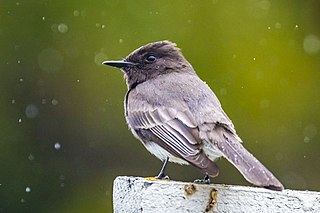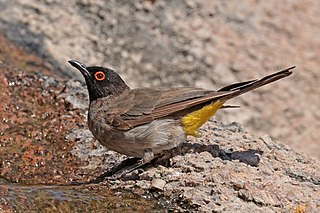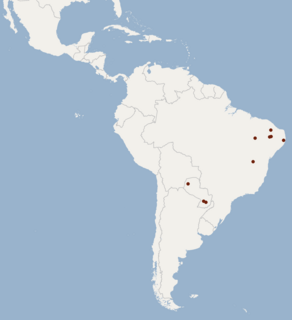Related Research Articles

A marlin is a fish from the family Istiophoridae, which includes about 10 species. It has an elongated body, a spear-like snout or bill, and a long, rigid dorsal fin which extends forward to form a crest. Its common name is thought to derive from its resemblance to a sailor's marlinspike. Marlins are among the fastest marine swimmers, reaching ~110 km/h (68 mph) in short bursts. However, greatly exaggerated speeds are often claimed in popular literature, based on unreliable or outdated reports.

Acanthosis nigricans is a medical sign characterised by brown-to-black, poorly defined, velvety hyperpigmentation of the skin. It is usually found in body folds, such as the posterior and lateral folds of the neck, the armpits, groin, navel, forehead and other areas.

The Atlantic blue marlin is a species of marlin endemic to the Atlantic Ocean. It is closely related to, and usually considered conspecific with, the Indo-Pacific blue marlin, then simply called blue marlin. Some authorities still consider both species distinct.

The black phoebe is a passerine bird in the tyrant-flycatcher family. It breeds from southwest Oregon and California south through Central and South America. It occurs year-round throughout most of its range and migrates less than the other birds in its genus, though its northern populations are partially migratory. Six subspecies are commonly recognized, although two are occasionally combined as a separate species, the white-winged phoebe.

The black softshell turtle or Bostami turtle, previously placed in genus Aspideretes, is a species of freshwater turtle found in India (Assam) and Bangladesh. It was long believed to be inbred individuals of the Indian softshell turtle or the Indian peacock softshell turtle, but while it is a close relative of the latter, it is a distinct species. In the 1800s it was believed these turtles were brought from Iran to Chittagong shrine pond by Hazrat Bayezid Bostami. His turtles he had brought to this pond were treated as sacred and respected by the public. Previously declared extinct by the International Union for Conservation of Nature in 2002, these turtles were found still to exist in a temple's pond called the Hayagriva Madhava Temple located in Assam, India. Through conservation methods and protection of the species, some of these turtles can be found today throughout the wild, and scientists and environmental biologists are continuing to work hard to preserve this endangered species and their natural habitat.

The black myotis, is a vesper bat species from South and Central America.
The putative Wych Elm cultivar Ulmus glabra 'Latifolia Nigricans' was first described, as Ulmus campestris latifolia nigricans, by Pynaert in 1879. Pynaert, however, did not specify what species he meant by U. campestris. The tree was supplied by the Späth nursery of Berlin in the late 19th century and early 20th as Ulmus montana latifolia nigricans. Späth, like many of his contemporaries, used U. montana both for Wych Elm cultivars and for those of the U. × hollandica group.
The elm cultivar Ulmus 'Nigrescens' was identified by Pynaert as Ulmus campestris betulaefolia nigrescens. Considered by Green to be "probably Ulmus carpinifolia , but said to have been raised from seed of Purpurea".

The Philippine mouse-deer, also known as the Balabac chevrotain or pilandok, is a small, nocturnal ruminant, which is endemic to Balabac and nearby smaller islands southwest of Palawan in the Philippines. The genus Tragulus means 'little goat' and the Philippine mouse-deer has been named so due to the horizontal pupils of the eyes. This position of the pupil allows for an increase in peripheral depth perception. It has traditionally been considered a subspecies of the greater mouse-deer. In 2004, though, T. nigricans was separated from T. napu as its own species due to differences in skull morphology. Contrary to its common name, the Philippine mouse-deer does not belong to the deer family Cervidae, but is a member of the chevrotain family.

The tree martin is a member of the swallow family of passerine birds. It breeds in Australia, mostly south of latitude 20°S and on Timor island. It is migratory, wintering through most of Australia, New Guinea, Indonesia east of the Wallace Line and the Solomon Islands. It is a vagrant to New Zealand, where it has bred, and New Caledonia. This species is frequently placed in the genus Hirundo as Hirundo nigricans.

The dusky lark, also known as the dusky bush lark or rufous-rumped bush lark, is a species of migratory lark in the family Alaudidae. It is native to the southern Afrotropics.

The African red-eyed bulbul or black-fronted bulbul is a species of songbird in the family Pycnonotidae. It is found in south-western Africa. Its natural habitats are dry savanna, subtropical or tropical dry shrubland, and riverine scrub. It feeds on fruit, flowers, nectar, and insects.

The red-necked pond turtle is a species of turtles in the family Geoemydidae endemic to China. It is most likely restricted to Guangxi and Guangdong provinces, although pre-historic skull remains have been found in northern Vietnam and Hainan. Other common names include Kwangtung river turtle and black-necked pond turtle.

The blackish white-toothed shrew is a species of mammal in the family Soricidae. It is endemic to Angola.

Lelis syndrome it is a genetic disorder, a rare condition with dermatological and dental findings characterized by the association of ectodermal dysplasia with acanthosis nigricans. Other clinical features may include palmoplantar hyperkeratosis, nail dystrophy, intellectual deficit, disturbances of skin pigmentation and hypodontia. Transmission is autosomal recessive.

Schoenus nigricans is a species of sedge known by the common names black bog-rush and black sedge. It is native to Eurasia, parts of Africa, Australia, and southern North America, including Mexico and the southernmost United States. It grows in many types of wetlands and other moist and alkaline habitat, including marshes, springs, seeps, peat bogs, heath, and alkali flats. This perennial plant grows in low, tight clumps 20 to 70 centimeters tall, with threadlike leaves bearing wide, dark brown ligules. The inflorescence is a small, flattened cluster of dark spikelets. The fruit is an achene coated in a hard, white shell.

Pterolophia is a genus of longhorn beetles of the subfamily Lamiinae, containing the following species:
Acanthocnemus nigricans is a species of Polyphaga beetle, the only species in the monotypic family Acanthocnemidae, and native to Australia. It is pyrophilous and attracted to forest fires.
The elm cultivar Ulmus 'Betulaefolia Nigrescens', the Black Birch-leaved Elm, reportedly a seedling of a purplish-leaved elm, was first described by Pynaert in 1879 as U. campestris betulaefolia nigrescens. An U. campestris betulaefolia nigrescensHort. was distributed by the Späth nursery, Berlin, in the 1890s and early 1900s.

LaVal's myotis is a species of bat found in Brazil and Paraguay.
References
- ↑ BioLib.cz - Pterolophia nigricans. Retrieved on 8 September 2014.